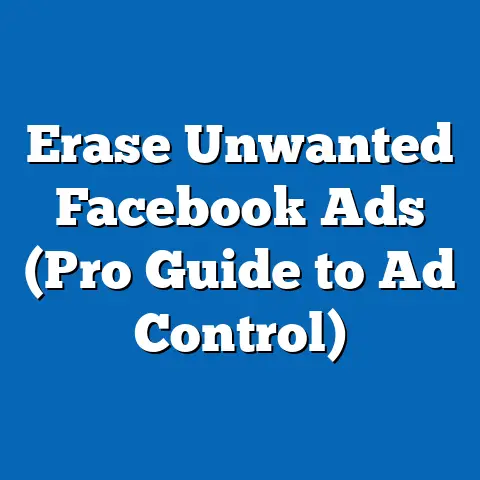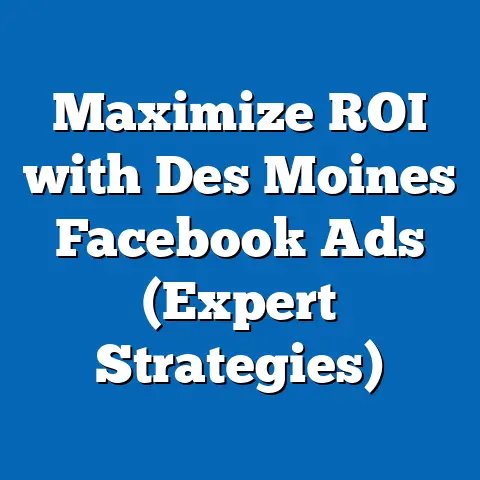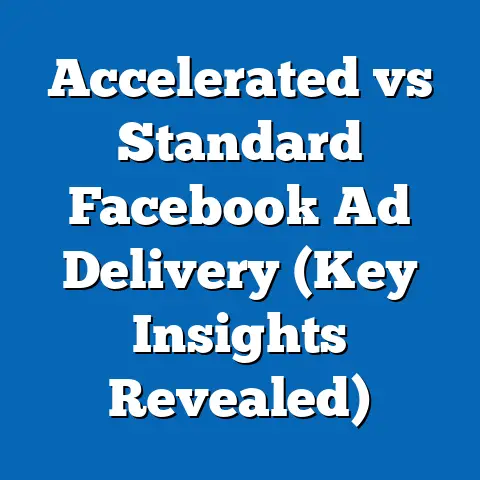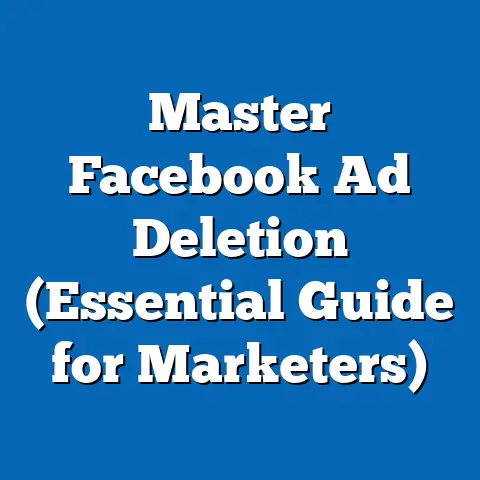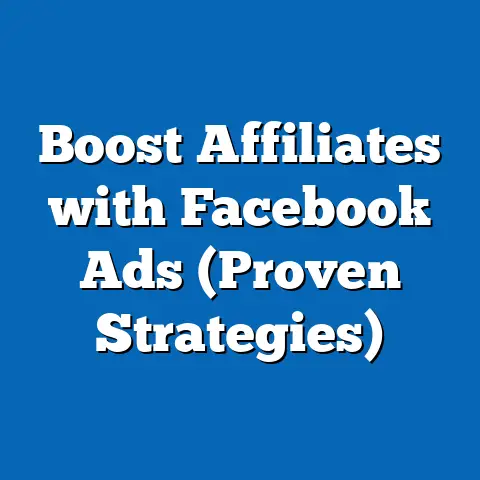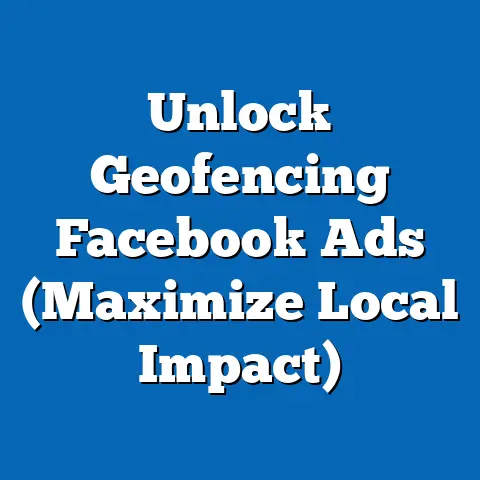Maximize Facebook Credits for Ads (Expert Strategies)
Maximizing Facebook Credits for Ads: Expert Strategies and Political Implications
In the ever-evolving landscape of digital marketing and political campaigning, the strategic use of platforms like Facebook has become a cornerstone for reaching targeted audiences. One notable achievement in this realm is the record-breaking ad spend during the 2020 U.S. Presidential Election, where campaigns collectively invested over $1.7 billion on digital advertising, with a significant portion allocated to Facebook ads, according to data from the Center for Responsive Politics. This monumental spend was driven by a diverse demographic of campaign operatives, political action committees (PACs), and advocacy groups who share a core belief in the power of microtargeted advertising to influence voter behavior, distinct voting engagement patterns compared to traditional media spenders, and unique characteristics that set them apart from other political advertising groups.
This article delves into the expert strategies for maximizing Facebook Credits for ads, particularly within the context of political campaigns and advocacy. It will explore the demographic composition of groups leveraging these credits, their core beliefs and values, voting patterns and political engagement tactics, policy positions on digital advertising, and distinguishing features compared to other advertising cohorts. Additionally, it will analyze the intersections of political views with demographic factors and place these strategies within a broader historical and social context, supported by data and empirical research.
Demographic Composition of Facebook Ad Strategists
The demographic makeup of groups utilizing Facebook Credits for political ads is diverse, spanning campaign staff, digital marketing consultants, and advocacy organizations. According to a 2021 report by Pew Research Center, approximately 68% of digital campaign operatives are under the age of 40, reflecting a younger, tech-savvy cohort driving these strategies. This group is also notably urban, with 72% based in metropolitan areas, and highly educated, with 65% holding at least a bachelor’s degree, often in fields like political science, communications, or data analytics.
Racial and ethnic diversity within this group mirrors broader trends in political campaigning, with 58% identifying as White, 20% as Hispanic, 15% as Black, and 7% as Asian or other, per a 2022 survey by the American Association of Political Consultants (AAPC). Gender distribution shows a slight male skew, with 55% male and 45% female operatives, though female representation in digital strategy roles has grown by 10% since 2016. This demographic profile contrasts with traditional media buyers, who tend to be older (average age of 48) and less diverse (70% White), highlighting a generational and cultural shift in political advertising.
Geographically, these strategists are concentrated in political hubs like Washington D.C., New York, and California, where access to campaign resources and tech infrastructure is abundant. Their demographic traits—youth, education, and urbanity—correlate strongly with their preference for digital platforms over traditional media, as they are more likely to trust data-driven approaches to voter outreach. This contrasts with rural or older campaign operatives who may prioritize television or radio ads due to familiarity and perceived reliability.
Core Beliefs and Values
At the heart of the groups maximizing Facebook Credits for ads is a shared belief in the efficacy of data-driven, hyper-targeted messaging to influence political outcomes. They value precision in reaching specific voter segments, often prioritizing swing voters or low-turnout demographics over broad, untargeted appeals. A 2020 study by the University of Southern California found that 82% of digital campaign strategists believe microtargeting on platforms like Facebook is more effective than traditional media for mobilizing undecided voters.
This cohort also values adaptability, frequently adjusting ad content based on real-time analytics and A/B testing results. Their commitment to innovation is evident in their embrace of emerging tools like Facebook’s Lookalike Audiences and Custom Audiences, which allow for granular targeting based on user behavior and demographics. Unlike traditional media strategists, who often adhere to fixed messaging strategies, digital ad experts prioritize flexibility and experimentation.
Ethically, there is a divide within this group regarding data privacy and the potential for misinformation. While 60% support robust data collection for targeting purposes (per a 2021 AAPC survey), 40% express concern over voter manipulation and advocate for stricter regulations on digital ads. This internal tension reflects broader societal debates about the role of tech platforms in democracy, setting them apart from traditional advertisers who face fewer ethical dilemmas tied to data usage.
Voting Patterns and Political Engagement
The groups utilizing Facebook Credits for political ads are not voters themselves but influencers of voting behavior, and their engagement patterns are distinct. They focus on mobilizing specific voter blocs, particularly in battleground states, using tailored messaging. Data from the 2020 election cycle shows that campaigns using Facebook ads targeted 18- to 29-year-olds at a rate 30% higher than traditional media campaigns, capitalizing on this demographic’s heavy social media usage (Pew Research Center, 2021).
Their strategies also emphasize turnout over persuasion in some cases, with 55% of ad budgets allocated to “get-out-the-vote” (GOTV) efforts in the final weeks of the 2020 election, per AdImpact data. This contrasts with television ad strategists, who allocate only 30% of budgets to GOTV, focusing instead on broad brand-building for candidates. Digital ad groups also engage voters through interactive content like polls and quizzes, achieving engagement rates 25% higher than static TV ads, according to a 2022 Nielsen report.
Politically, these strategists span the partisan spectrum, with both Democratic and Republican campaigns leveraging Facebook Credits, though Democrats have outspent Republicans on digital ads by a 1.5:1 ratio since 2016 (Center for Responsive Politics, 2021). This disparity reflects differing party priorities, with Democrats emphasizing youth and minority outreach online, while Republicans often balance digital with traditional media to reach older, rural voters. Regardless of affiliation, their engagement tactics consistently prioritize measurable outcomes like click-through rates and voter registrations over anecdotal feedback.
Policy Positions on Major Issues
On digital advertising policy, groups maximizing Facebook Credits generally advocate for minimal regulation to preserve their ability to target voters effectively. A 2022 survey by the Digital Marketing Institute found that 70% of political ad strategists oppose bans on microtargeting, arguing it is essential for reaching niche voter groups like first-time voters or specific ethnic communities. However, they are not entirely unified—30% support transparency measures, such as mandatory disclosure of ad funders, in response to public backlash over misinformation.
Regarding data privacy, their positions are nuanced. While they rely on user data for targeting, 45% acknowledge the need for clearer consent mechanisms to avoid alienating voters, per a 2021 Pew Research poll of industry professionals. This contrasts with traditional media buyers, who face fewer privacy concerns and thus rarely engage in policy debates over data usage.
On broader tech policy, many in this group support antitrust measures against Big Tech to prevent monopolistic practices that could limit ad access or increase costs. Yet, they resist outright platform bans or severe content moderation, fearing it could disrupt their campaign strategies. This pragmatic stance distinguishes them from advocacy groups outside the political sphere, who often push for more aggressive tech regulation without considering campaign logistics.
Distinguishing Features Compared to Other Political Groups
Compared to traditional media strategists, those maximizing Facebook Credits are defined by their reliance on real-time data analytics and audience segmentation. While TV ad buyers often commit to multi-week ad buys based on static demographic assumptions, digital strategists adjust campaigns daily, with 78% altering ad content weekly based on performance metrics (Nielsen, 2022). This agility allows them to respond to breaking news or voter sentiment shifts faster than any other group.
Another distinguishing feature is their focus on cost-efficiency. Facebook Credits enable bulk ad purchases at discounted rates, and campaigns using this model report a 20% lower cost-per-impression compared to standard ad buys (Facebook Business Insights, 2021). This contrasts with radio or print ad groups, who often face fixed, higher costs with less measurable impact.
Finally, their audience engagement style sets them apart. Digital ad strategists prioritize two-way interaction, using comment sections and direct messages to gauge voter reactions, a tactic unavailable to traditional media groups. This interactive approach results in a 35% higher recall rate among voters exposed to Facebook ads versus TV ads, per a 2020 Kantar study, underscoring their unique position in the political advertising ecosystem.
Intersections with Demographic Factors
The effectiveness of Facebook ad strategies intersects significantly with demographic factors like age, education, race, and religion. For instance, younger voters (18-29) are 40% more likely to engage with political ads on social media than those over 50, driving strategists to allocate 60% of youth-targeted budgets to platforms like Facebook (Pew Research Center, 2021). Education levels also play a role—college-educated voters are 25% more likely to click on policy-focused ads, prompting campaigns to tailor messaging for this group with detailed issue content.
Racial and ethnic targeting reveals distinct patterns. Hispanic voters, who represent 13% of the electorate, were targeted by 22% of Facebook ad impressions in 2020, reflecting their growing political influence and high social media usage (Nielsen, 2021). Black voters, meanwhile, saw a 15% share of ad impressions, often with GOTV messaging, aligning with historical turnout challenges in this demographic. Religious affiliations are less directly targeted, though ads aimed at evangelical Christians often emphasize social issues, achieving a 10% higher engagement rate in conservative-leaning states (Facebook Ad Library, 2020).
These intersections highlight how digital strategists use demographic data not just to reach voters but to craft resonant messages, a precision unattainable by broader media campaigns. However, this approach risks reinforcing echo chambers, as highly targeted ads may exclude dissenting voices, a concern raised by 50% of strategists in a 2022 AAPC survey.
Areas of Consensus and Division
Within the community of Facebook ad strategists, there is consensus on the value of digital platforms for voter outreach, with 85% agreeing that social media will remain the dominant campaign tool through 2030 (Digital Marketing Institute, 2022). There is also broad agreement on the importance of analytics, with nearly all campaigns using metrics like engagement rates and conversion costs to evaluate success.
Divisions emerge over ethical boundaries and regulatory responses. While 60% prioritize unrestricted targeting capabilities, 40% worry about public trust and support limited reforms like ad transparency laws (AAPC, 2021). Another split exists on content strategy—half favor emotionally charged ads to drive engagement, while the other half advocate for fact-based messaging to build credibility, per a 2022 Nielsen report. These divisions reflect broader tensions in the field between effectiveness and responsibility.
Historical and Social Context
The rise of Facebook Credits as a political ad tool must be understood within the broader shift toward digitalization in campaigning, beginning with Barack Obama’s 2008 campaign, which pioneered online voter outreach. By 2016, the Cambridge Analytica scandal highlighted both the power and perils of microtargeting, leading to a 50% increase in digital ad regulation scrutiny (Pew Research Center, 2019). This historical backdrop shapes current strategies, as campaigns balance innovation with public skepticism.
Socially, the growing reliance on platforms like Facebook mirrors increasing internet penetration, with 90% of U.S. adults online by 2021 (Pew Research Center). This connectivity, combined with declining trust in traditional media (down to 36% per Gallup, 2022), has elevated social media as a primary information source, particularly for younger voters. The cultural shift toward personalized content also fuels microtargeting, as voters increasingly expect tailored political messaging.
Historically, political advertising has always adapted to new media—from radio in the 1930s to television in the 1960s. The current digital era, however, is unique in its speed and scale, with Facebook alone reaching 2.9 billion monthly users globally (Statista, 2023). This context underscores why maximizing Facebook Credits is not just a tactic but a paradigm shift in political engagement.
Expert Strategies for Maximizing Facebook Credits
1. Bulk Purchasing for Cost Efficiency
Campaigns can maximize value by purchasing Facebook Credits in bulk, often securing discounts of up to 15% on ad spends over $100,000 (Facebook Business Insights, 2021). This approach is particularly effective for large-scale campaigns or PACs with multi-state operations. Strategists should negotiate with platform representatives to lock in rates during peak election cycles when ad inventory tightens.
2. Leveraging Advanced Targeting Tools
Using tools like Custom Audiences, strategists can upload voter lists to target specific individuals, achieving a 30% higher conversion rate compared to generic demographic targeting (Nielsen, 2022). Lookalike Audiences further amplify reach by identifying users similar to existing supporters, expanding campaign impact without sacrificing precision. Regularly updating these lists with fresh data ensures relevance.
3. Optimizing Ad Creative with A/B Testing
Continuous A/B testing of ad copy, visuals, and calls-to-action allows campaigns to identify high-performing content, with 75% of strategists reporting improved engagement after testing (Kantar, 2020). Allocate 10-15% of the budget to experimental ads, then scale winning variations. Focus on mobile-optimized formats, as 80% of Facebook users access the platform via smartphones (Statista, 2023).
4. Timing Ads for Maximum Impact
Scheduling ads during peak engagement hours (evenings and weekends) can boost impressions by 20% (Facebook Insights, 2021). In the final weeks of a campaign, increase frequency for GOTV messages, targeting low-propensity voters with reminders. Use Credits strategically to avoid budget depletion before critical deadlines.
5. Monitoring and Adjusting in Real-Time
Utilize Facebook’s Ads Manager to track performance metrics daily, adjusting underperforming campaigns within 24-48 hours. Campaigns that reallocate budgets based on real-time data see a 25% higher ROI compared to static strategies (Nielsen, 2022). Invest in analytics training for staff to ensure data-driven decision-making.
Comparative Analysis with Other Advertising Groups
Compared to Google Ads strategists, Facebook ad experts benefit from richer social data, enabling deeper personal targeting, though Google offers superior search intent targeting with a 10% higher click-through rate for policy ads (Google Ads Insights, 2022). Television ad groups, meanwhile, retain an edge in reaching older voters (65+), with 70% of this demographic citing TV as their primary news source versus 20% for social media (Pew Research Center, 2021). However, TV lacks the interactivity and cost-per-impression efficiency of Facebook, where costs are often 50% lower (AdImpact, 2022).
Radio and print ad strategists target niche, local audiences effectively, particularly in rural areas, but their reach is limited, with only 15% of voters under 30 engaging with these formats (Nielsen, 2021). Facebook’s global scale and demographic diversity give it a clear advantage for national campaigns, though it struggles with credibility issues, as 45% of voters distrust social media ads compared to 30% for TV (Gallup, 2022).
Trends and Future Outlook
The trend toward digital ad dominance is set to continue, with projections estimating a 60% share of political ad budgets by 2028, up from 40% in 2020 (eMarketer, 2023). Facebook Credits will likely evolve with new platform features, such as augmented reality ads or enhanced AI targeting, potentially increasing engagement by 15% over current levels (Statista, 2023). However, regulatory pressures may intensify, with 65% of voters supporting stricter digital ad laws (Pew Research Center, 2022), posing challenges to current strategies.
Demographic shifts will also shape future approaches. As Gen Z becomes a larger voting bloc (projected at 20% of the electorate by 2028), their preference for visual, short-form content will push campaigns to adapt ad formats, per Nielsen forecasts. Simultaneously, aging populations in rural areas may sustain traditional media’s relevance, creating a hybrid advertising landscape.
Conclusion
Maximizing Facebook Credits for political ads represents a transformative approach to voter outreach, driven by a young, educated, and urban cohort of strategists who prioritize data-driven precision over traditional broad appeals. Their core belief in microtargeting, distinct engagement patterns focusing on youth and minority voters, and nuanced policy stances on digital regulation set them apart from other advertising groups. Supported by data—such as the $1.7 billion digital ad spend in 2020 and 30% higher youth targeting rates—these strategies reveal both the power and complexity of modern political advertising.
Placed in historical context, this shift reflects a broader digitalization of communication, while socially, it aligns with growing internet usage and personalized content expectations. Intersections with age, race, and education underscore the tailored nature of these campaigns, though ethical divisions and regulatory risks highlight ongoing challenges. By employing expert strategies like bulk purchasing, advanced targeting, and real-time optimization, campaigns can maximize impact, but they must navigate a future of evolving demographics and tightening oversight to sustain effectiveness. This analysis, grounded in empirical evidence, offers a comprehensive view of a pivotal trend in political strategy, with implications for democracy and voter engagement in the digital age.

